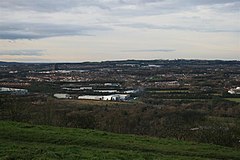Washington (Tyne and Wear)
| Washington | ||
|---|---|---|
| Washington from the Penshaw Monument | ||
| Coordinates | 54 ° 55 ′ N , 1 ° 32 ′ W | |
|
|
||
| Residents | 67,158 (as of 2016) | |
| administration | ||
| Post town | WASHINGTON | |
| ZIP code section | NE37, NE38 | |
| prefix | 0191 | |
| Part of the country | England | |
| region | North East England | |
| Metropolitan county | Tyne and Wear | |
| Metropolitan Borough | City of Sunderland | |
| British Parliament | Washington and Sunderland West | |
Washington is a city in northeast England . It belongs to the Metropolitan County of Tyne and Wear and the Metropolitan Borough City of Sunderland . Washington has 55,454 inhabitants (2001) and is located around 10 km west of Sunderland and southeast of Newcastle upon Tyne .
Washington was given the status of a New Town in 1964 , so it is one of the cities that were subject to planned urban development after the Second World War, so that the population of the commuter community has grown rapidly in recent decades and a number of new housing developments have been created. In the center of Washington are The Galleries , a shopping center opened in 1974 with several supermarkets; the galleries are in the immediate vicinity of the Princess Anna Park.
history
The place is first mentioned in 1096 as Wasindone ; The name is probably derived from waesc ('waters') and dun ('hill'), which means something like: place of the people who live on the hill by the river, a reference to the nearby river Wear . However, a derivation as a “settlement of Wassa” cannot be ruled out (see the article on the name Washington ).
The mansion Old Hall was completely renovated in the 17th century, so that little reminds of the medieval structure. The rural community in what was then County Durham experienced an upswing in industrialization through the coal mines in the area; New workers' settlements were built around the coal mines. The F-Pit-Museum (named after the F pit, the mines were named after the alphabet) reminds of the time. Railways brought the coal down to the Wear and to Sunderland , from where it was shipped. In addition to coal mining, the chemical industry developed in Washington in particular in the 19th century; the most important representative of this branch was the company Cape / Newalls, which manufactured insulation. Here, too, a separate workers' settlement developed with Pattinson.
George Washington's roots
In 1183 William de Hertburn moved to the city (then Wassyngtona ) and had the Old Hall built for himself as a country residence, and from then on called himself William de Wassyngtona after the place . William is an ancestor of the Washington family (and thus also George Washington , the 1st President of the USA), who moved to Sulgrave Manor in Northamptonshire in 1539 and finally to Virginia in 1657 , ironically because of their pro-royalist stance who emigrated from England.
A celebration is held in the Old Hall every 4th of July in honor of George Washington .
economy
Today the textile, electrical and automotive industries are the most important branches. The largest employer is the vehicle manufacturer Nissan Motor Manufacturing (UK) Ltd.
Attractions
In addition to the F-Pit Museum , the nature reserve established by the Wildfowl and Wetlands Trust in 1975 is particularly worth seeing, where not only flamingos but also swans, ducks and geese are kept. Not far from Washington is the North of England Open Air Museum , an open-air museum that shows the visitor the reconstruction of a typical northern English industrial town at the beginning of the 20th century. The Washington Arts Center is housed in a former farmhouse and houses artist studios and a recording studio next to the city theater. There is an aviation museum on the old RAF base in Usworth ; Efforts to set up a civil airport in Washington have so far failed.
education
Washington has 14 elementary schools and five high schools.
traffic
Despite its importance as a mining town in the northern English coal mining area, Washington today has no rail connection and is therefore (alongside Gosport ) one of the largest British cities without a train station. Plans to extend the Tyne and Wear Metro from Newcastle to Washington have not yet been implemented. There is a bus station at the galleries. The next motorway is the A1 on the western edge of the city.
Personalities
- Gertrude Bell (1868–1926), writer
- Bryan Ferry (* 1945), musician, singer with Roxy Music
- Jordan Pickford (born 1994), football player
and in a broader sense as the honored 'son' of the city:
- George Washington (1732–1799), President of the United States of America
Web links
Individual evidence
- ^ A guide to Washington. In: Information Britain. Retrieved March 21, 2010 (English).


